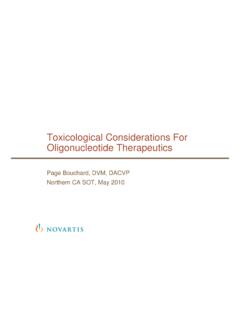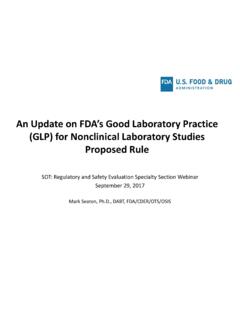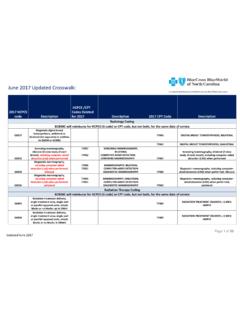Transcription of Genotoxic impurities in small molecule drug candidates
1 Assessment of Genotoxic impurities in small molecule drug candidates John Wisler, PhD, DABT. Kurt A Black, , DABT. Comparative Biology and Safety Sciences, Amgen Inc. Northern California SOT Meeting 06-May-2010. Outline Genotoxic impurities (GTIs). Background and regulatory framework Assessment of impurities for Genotoxic potential Setting limits for GTIs Examples and case study Summary 2. Background small molecule impurities impurities occur in essentially all small molecule drug substances (DS, API) and drug products (DP). impurities have the potential to cause adverse effects impurities provide no benefit to patients Starting materials and intermediates are common impurities Reactive by nature May be Genotoxic Not feasible to completely avoid use Need to ensure that level of impurity is sufficiently safe to administer to humans 3.
2 Why Are We Now More Focused on Genotoxic impurities ? Increased regulatory expectations January 2007. EMEA CHMP Guideline on the Limits of Genotoxic impurities February 2008. EMEA letter requesting evaluation of sulfonic esters in all marketed products June 2008 and December 2009. EMEA Questions & Answers Documents on the CHMP Guideline on the Limits of Genotoxic impurities December 2008. FDA Draft Guidance for Industry: Genotoxic and Carcinogenic impurities in drug Substances and Products; Recommended Approaches Increased attention from industry Position paper: M ller L et al., Regul Toxicol Pharmacol 44: 198- 211,2006. 4. Why Are We Now More Focused on Genotoxic impurities ?
3 Viracept (nelfinavir mesylate). HIV protease inhibitor marketed by Roche in EU. EMEA suspended marketing in June, 2007. Contamination with ethyl methanesulfonate (EMS). Classic genotoxin Formed from reaction between residual ethanol and methyl sulfonic acid counter ion CH3SO3H + C2H5OH CH3SO3C2H5. EU marketing authorization reinstated in October, 2007. Contamination problem resolved Roche was requested to conduct toxicity studies to better assess risk to exposed patients 5. ICH impurities Guidance Documents ICH Q3A(R2) and ICH Q3B(R2). impurities in New drug Substances/Products Limits for reporting, identification and qualification Qualification Process of acquiring and evaluating data that establishes the biological safety of an impurity, eg.
4 , toxicology studies Lower thresholds may be appropriate for unusually toxic impurities . Genotoxins ICH Q3C(R4). Residual Solvents Permissible Daily Exposure (PDE). NOAEL/LOAEL + safety factors + interspecies scaling 6. ICH Q3A Thresholds for drug Substance impurities GTI guidances often result in control to levels well below ICH limits 7. EMEA Guidance on The Limits of Genotoxic impurities Limit Genotoxic impurities in DS and DP must be to levels associated with negligible risk Threshold of Toxicological Concern (TTC). Maximal daily intake of a Genotoxic impurity at which negligible increased risk for cancer exists Generic limit based on database of several hundred Genotoxic rodent carcinogens Use for Genotoxic impurities with unknown carcinogenicity At marketing TTC = g/day For pharmaceuticals, risk factor = 1 x 10-5.
5 Clinical development Staged limits based on duration of treatment Risk factor of 1 x 10-6 and additional safety factor of 2 . A compound-specific limit should be used if sufficient data exist Eg, rodent carcinogenicity data or demonstrated threshold Also see M ller et al., 2006. 8. Staged TTC EMEA Guidance Duration of Clinical Exposure Single >Single >1 month to >3 months >6 months >12 months Dose dose to !3 months to to or at !1 month !6 months !12 months marketing Staged TTC 120 60 20 10 5 (_g/day). Higher levels acceptable for certain conditions Life-threatening conditions Life expectancy < 5 years Human exposure much greater from other sources High potency compounds need to be limited to below generic TTC.
6 Aflatoxin-like, N-nitroso-, azoxy-compounds Compound-specific limit required 9. FDA Draft Guidance on GTIs Released for comment in December 2008. Generally aligned with EMEA guidance Exception Level of 120 g/day acceptable for less than 14 days rather than just for single dose Likely to be withdrawn if GTIs accepted as new ICH. topic 10. Relationship Between Staged TTC, drug Dose and Impurity Concentration Limit Many values are below ICH qualification limits (1500 ppm). 11. Setting Compound-specific Limits Genotoxic , rodent carcinogens Compound-specific limit using cancer risk assessment models Cancer slope factors Linearized multistage model of cancer risk assessment based on rodent carcinogenicity data Regulatory agency limits USEPA, CalEPA.
7 Cancer potency database (U of CA-Berkeley). Adjust for appropriate risk factor and duration of treatment May be lower or higher than generic TTC. See detailed description of approach in M ller et al., 2006. 12. A Confidential What About Life-threatening Conditions? Do Same Limits Apply? Oncology indications as defined in ICH S9, Step 4. Advanced, life-threatening disease Studies in patients Genetox on API not needed until registration Genotoxic impurities Limits based on normal lifetime exposure are not appropriate Higher limits could be justified Minimize delayed access to or withdrawal of potentially effective treatments Other oncology indications Long life-expectancy, maintenance therapy, supportive care, healthy volunteer trials Use same approach as for non-oncology indications 13.
8 Assessment of Potential Genotoxic impurities Highly Cross-functional Approach Needed ra l Process M. u ct at ru erts Chemistry er es t S al Am ia lf or In-silico Qua t dat men Genotoxic ory lity Ames impurities op a at vel Assessment ul De Reg To a l xic ic yt olo al An gy Lim its thods Me 14. GTI Assessment for 1st GMP Process Process Chemistry assesses synthetic scheme to identify compounds with structural alerts Starting materials, intermediates, reactants, obvious by-products Simply looking for alerting structures, not SAR. Process Chemistry and Analytical Chemistry modify the initial list Chemical feasibility of carry over to API (expert judgment). Actual analytical data Toxicology performs safety evaluation of high priority compounds Known API impurities and those with high probability to occur Classify compounds as Genotoxic or routine impurities Propose limits Proposed testing and control strategies developed by cross- functional team Process Chemistry, Analytical Chemistry, Toxicology, Quality, and Regulatory CMC.
9 Specifications 15. Chemistry Assessment of Process Presence of structural alerts Functional groups associated with mutagenicity Expert judgment Eg., aromatic amine Chemical feasibility of appearing in API. A Genotoxic starting material in the first step of a 5-step synthetic process is unlikely to appear in API. Genotoxic substance could be destroyed or rejected in subsequent step(s). Analytical data Verifies presence of Genotoxic impurity Methods, especially early, may not have sensitivity at levels below TTC. 16. Structural Alerts from National Toxicology Program Tennant RW et al., Mutat Res 257:209-227, 1991. 17. Structural Alerts Pharmaceutical impurities Structural Alerts for Mutagenicity Group 1: Aromatic Groups A.
10 A. OH. N A. N. N. A. A. O N+. O- N-Hydroxyaryls N-Acylated aminoaryls Aza-aryl N-oxides Aminoaryls and alkylated aminoaryls Purines or Pyrimidines, Intercalators, PNAs or PNAHs Group 2: Alkyl and Aryl Groups O. OH A. O. NO2 O NH2. N N A. A H A A A NO A. Aldehydes N-Methylols N-Nitrosamines Nitro Compounds Carbamates (Urethanes). O. Halogen A R. O NH O C (or S) N N. A A. A A A A S or N Hydrazines and Propiolactones N or S Mustards Epoxides Aziridines Azo Compounds Propiosultones (beta haloethyl). Group 3: Heteroatomic Groups O Halogen A. O. Halogen EWG P S. Michael-reactive OR OR Primary Halides Acceptors Halo-alkenes (Alkyl and aryl-CH2). Alkyl Esters of Phosphonates or Sulfonates Legend: A = Alkyl, Aryl, or H.












